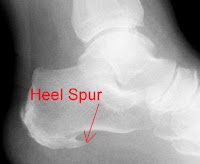First thing in the morning, you get out of bed, put your feet on the floor and BAM! You get a searing pain in the undersurface of your heel. As you walk around it seems to get better. You most likely have plantar fasciitis. The plantar fascia, also known as the plantar aponeurosis, is a thickened connective tissue band that holds the arch of the foot. It’s shown in the image below as a red band.
When you suffer from plantar fasciitis, there is inflammation (that’s what “-itis” means) of the fascia. Usually the pain is found where the fascia attaches to the heel. That is not necessarily the case, however. As you can see in the next picture, a study of 2,666 patients found the pain can regularly occur anywhere along the fascia.
Before we go into what you probably don’t know about plantar fasciitis, let’s cover what you probably do know:
- Wear a cushioning shoe with an arch support. Plantar fasciitis is found more often in over pronators. Over pronators, or people with fallen arches, will stretch out the fascia more. DON’T use orthotics in your running shoes! To find out why go here.
- Increasing your running distance or being overweight increase your risk. These things place extra demand on the plantar fascia. If you’re carrying a little extra weight work towards trimming down. If you are a runner be sure to follow the 10% rule, which states never increase your distance any more than 10% week to week. This will allow your support structures time to adapt to the increased demands.
- Rest is required. Rest is required for proper recovery. If you start working out too soon you simply risk missing more time from your sport.
- Run on soft ground. When running on a hard surface like the sidewalks, you will stretch out your fascia more. Soft ground is a more forgiving surface. Nanaimo has some fantastic trails, get off road!
Those are the basics and if you’ve read anything about this condition undoubtedly you’ve come across the above advice. But what about the info you probably haven’t heard:
- Anti-inflammatories are a BAD idea. “What?! But everything I’ve heard says use anti-inflammatories.” Yes, I know, but it is outdated information. More recent research has proven that over the counter anti-inflammatories actually slow the healing of ligament, muscle, tendon and bone. Read the research here. Throw the anti-inflammatories in the garbage.
- Calf stretches are needed. Over tight calf muscles lead to excessive pronation. You need to stretch out the two main muscles of the calf; the gastrocnemius and the soleus. There are three stretches that any good sports injury practitioner should provide.
-
 Heel spurs do not cause plantar fasciitis. It used to be thought that bony spurs found on the bone of the heel caused plantar fasciitis. However, there is no correlation between heel pain and the presence of a bony spur. Many people who never have had plantar fasciitis have heel spurs. The finding of a heel spur is an incidental finding but is often identified (incorrectly) as the source of the pain. So if you have a spur, fear not, with proper treatment you should be able to recover form plantar fasciitis and return to activity.
Heel spurs do not cause plantar fasciitis. It used to be thought that bony spurs found on the bone of the heel caused plantar fasciitis. However, there is no correlation between heel pain and the presence of a bony spur. Many people who never have had plantar fasciitis have heel spurs. The finding of a heel spur is an incidental finding but is often identified (incorrectly) as the source of the pain. So if you have a spur, fear not, with proper treatment you should be able to recover form plantar fasciitis and return to activity. - Ultrasound is useless for treating plantar fasciitis. Again, you might find this surprising because this treatment is used so commonly. A clincial study conducted by the medical department at the University of Sheffield and the London Foot Hospital found that ultrasound treatment was no more effective than a fake treatment.
- Fixations in the ankle bones may be the ultimate cause of your pain. Your ankle consists of 7 bones. Proper walking and running mechanics depend on normal motion between these bones. Fixations, also known as misalignments, of these bones will result in their work being put on the neighbouring plantar fascia. This results in plantar fasciitis. You can read the research here. Find yourself a chiropractor experienced in dealing with sports injuries to have your mechanics tested.





Running puts great stress on our bodies, even when we do it right. That is why stretching, strengthening and cross training are so important to remaining in balance.
Regular chiropractic care can help you run longer and more efficiently by addressing musculoskeletal, and nutritional issues prior to the onset of injury.
I find it a rather weird experience on reading about plantar fasciitis after I recovered from it two months ago. It was painful as I felt that I had barbed wires inside my heel.
heel pain treatment
I disagree that ultrasound cannot heal plantar fasciitis. My chiropractor in Florida miraculously healed my heel with ultrasound therapy after years of struggling with chronic plantar fasciitis. That was in 2005. It is now 2012 and I have remained completely free of heel pain since then.